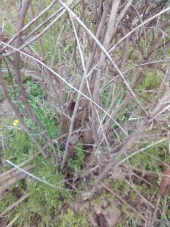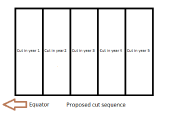posted 4 years ago
Hi all,
I'm in western Oregon, ag zone 8b. I live in a 1950s era suburbia house with a big back yard. In February we had a horrendous freezing rain event, and the sheer weight of the ice encapsulation on trees caused mass tree/branch falls around my area. In my own back yard, I previously had a trio of black locust trees in the back yard, likely several decades old-- trunks about 10-13 inch diameter, and about 40ft tall. In the storm, two of the trees came down. They didn't snap, but rather tipped right over straight from the roots. February is a time of year when our soil is so saturated after 4+ months of rain, so I'm not shocked that that's the way the trees came down-- the soil is practically chocolate pudding here in February and March every year.
My landlady and her husband came to help me cut up and organize/clear away the trees a couple of weeks after they fell. They're permie type people themselves, and landlady's husband is a woodworker and forester, so they took away the largest parts of the trunks, cut into long pieces, which they plan to use as corner posts for some structures. I kept some of the 1-6 inch diameter stuff for firewood, and they took away all the young top branches that are hardly big enough for kindling.
I already know that black locust are wonderful coppicing trees, and I also know they are very good at coming back from the stump or even from the root system, so I wondered what might develop from these two trees that were now sawn off about a foot above the ground but with the stumps sitting at odd angles from the way the root system tipped over. Sure enough, in early or mid April a few little shoots started to emerge both from the stumps, but also from what must have been the root systems that sprawled out across half of my yard. I thought I'd let them grow out a bit, then thin down to 3-6 with some spacing, so that they can eventually replace the mother trees that were lost.
Fast forward a couple months, here we are at late July and now I have a dense thicket of dozens and dozens of young plants, 5-10 feet tall already, with another 8-10 young plants at satellite locations scattered across my yard, obviously coming up from the healthier roots of the fallen trees. If you know anything about black locusts, you know they are THORNY even/especially at this young stage. Big old half inch long thorns. I find it to be a beautiful adaptation to deter browsing animals from killing them before they can get established. Unfortunately, this is also making it difficult for me to figure out how to approach thinning these out. If I was out in the country, I'd just borrow a couple of goats from someone, let them munch away for a week, and then have a clearer picture of how to carefully reach into the densely packed grouping of plants and thin them down to a reasonable number of well spaced trees.
As it stands, though, I live in a city that barely allows two backyard chickens, so bringing in rented goats is just not gonna be possible. The gear I currently own to tackle this are wrist-length low quality leather gloves, hand pruners, and one pair of long handled loppers (that desperately need a pro sharpening). Trying to decide right now whether to try to tackle this task now/soon before they get any bigger, and while they are lush with voluminous greens that block my view of what I'm really hacking at-- or if I should wait until November or so when they've lost their leaves and the view into the thicket will be clearer.
I don't have photos right now but can take some this evening and post them in a reply later. What are your thoughts/ideas? Keeping in mind this is a 8,000sq ft suburban back yard surrounded closely on all sides by neighbors, power lines, etc, so options are different than they might be in a rural area.
Thanks!
Today is a very exciting time in my life. I am on a wonderful adventure and will never go through this particular experience again.






